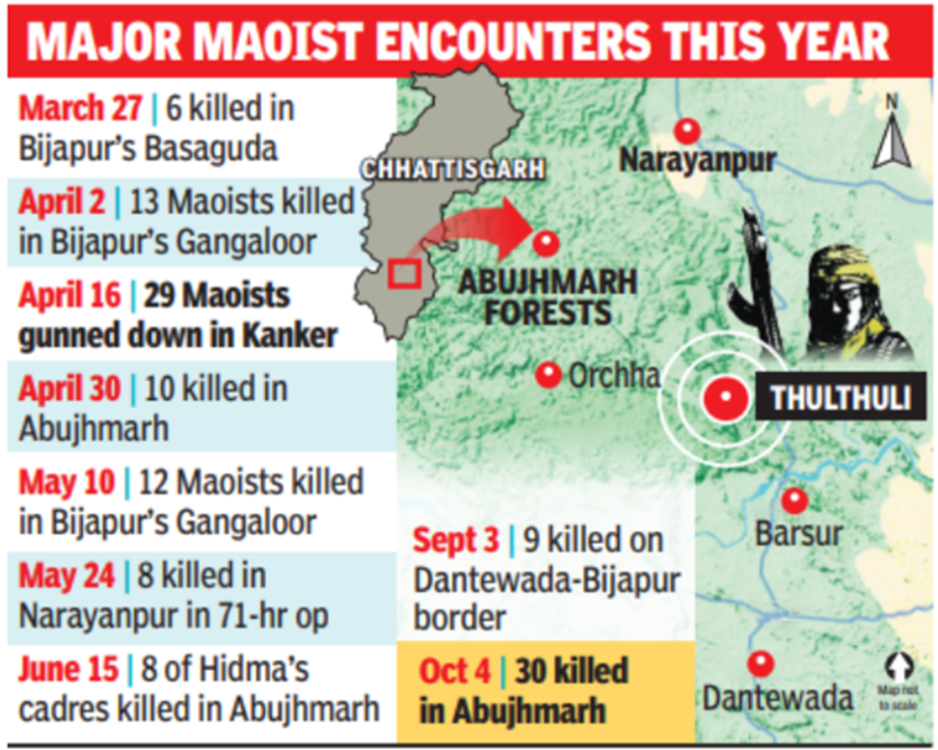Context:
In a decisive battle against left-wing extremism, Indian security forces have killed 31 Maoists during a fierce encounter in Chhattisgarh's Narayanpur district. This operation, conducted by the District Reserve Guard (DRG) and the Special Task Force (STF), signifies one of the most significant victories against Maoist insurgents in recent years.
As a result of the encounter, authorities reported the recovery of a substantial cache of weapons, including AK-series rifles and light machine guns. The operation has raised the total number of Maoists killed in 2024 to 186, a significant increase compared to previous years, highlighting the intensified efforts of security forces.

Significance of the Operation:
Increased Momentum: The operation marks a significant increase in anti-Maoist operations in Chhattisgarh, with over 131 Naxals eliminated in 2024, compared to 24 in 2023 .
Strategic Location: Narayanpur district is a key stronghold of Maoist insurgents, and the operation's success will help disrupt their operations and morale.
Interagency Cooperation: The joint operation involving District Reserve Guards, Special Task Force, and Indo-Tibetan Border Police (ITBP) demonstrates improved interagency coordination and cooperation.
What is left-wing extremism or naxalism?
The Naxalite movement in India, originating in the village of Naxalbari in West Bengal, began as a rebellion against local landlords in 1967. This uprising, spearheaded by Charu Majumdar and Kanu Sanyal, was ignited by a land dispute but quickly evolved into a broader revolutionary movement, gaining traction in less developed regions of Eastern India.
Key Objectives of the Naxalite Movement:
- Overthrow of the Indian Government: The Naxalite movement seeks to overthrow the existing Indian government through armed revolution, viewing this as a necessary step toward fundamental social change.
- Establishment of a Communist State: The movement aims to create a communist state rooted in Maoist principles, advocating for a system that aligns with Marxist-Leninist ideologies.
- Addressing Socio-Economic Grievances: Naxalites focus on addressing socio-economic injustices faced by marginalized communities, believing that armed struggle and people's war are essential methods to rectify systemic inequalities.
Tactics Employed by Naxalites:
- Guerrilla Warfare: Naxalites conduct surprise attacks on security forces, utilizing hit-and-run tactics to inflict damage while minimizing their own casualties.
- Extortion: They often force individuals and businesses to provide financial support, thereby funding their operations and maintaining their influence.
- Intimidation and Propaganda: By spreading fear and disseminating propaganda, Naxalites seek to manipulate public perception and rally support for their cause.
Strategic Objectives:
The ultimate aim of the Naxalite movement is to capture state power through armed insurgency, mass mobilization, and strategic alliances. Their targets include:
- Government Institutions: Naxalites aim to disrupt official functions and undermine governmental authority.
- Infrastructure: They damage or destroy critical infrastructure such as roads and bridges to hinder state operations and disrupt connectivity.
- Economic Interests: Attacks on businesses and economic hubs are designed to weaken the financial foundations of the state.
- Collaborators and Informants: Identifying and punishing those who cooperate with the government serves to instill fear and deter potential informants.
Parallel Governance:
Interestingly, in areas under their control, Naxalites have established parallel governance structures. They provide basic services and dispense justice, which helps them gain legitimacy and support among local populations. This duality allows them to present themselves as alternatives to the state, especially in regions where government presence is minimal.
Current Status of Left-Wing Extremism (LWE):
- 76% reduction in LWE violence incidents in 2022 compared to 2010
- 90% reduction in resultant deaths (from 1,005 in 2010 to 98 in 2022)
- Geographic spread of violence reduced, with districts reporting violence decreasing from 96 (2010) to 45 (2022).
- Overall, LWE incidents decreased by 36% in 2022 compared to 2018, with resultant deaths down by 59%.
- In Chhattisgarh, incidents decreased by 22% and resultant deaths by 60%.
Government Initiatives to Combat Left-Wing Extremism (LWE) in India:
- Left-Wing Extremism (LWE) continues to pose a significant challenge across multiple states in India, including Chhattisgarh, Jharkhand, Odisha, Bihar, West Bengal, Andhra Pradesh, Telangana, Maharashtra, Madhya Pradesh, and Kerala. The Indian government has recognized the urgency of this issue and implemented various measures aimed at tackling it comprehensively.
- Constitutional Context:
- Police and Public Order are State subjects as per the Seventh Schedule of the Constitution of India. The Government of India (GoI) supplements the efforts of State Governments affected by LWE.
- National Policy and Action Plan
- In 2015, the government approved a National Policy and Action Plan that takes a holistic approach to combat LWE. This strategy focuses on three main pillars:
- Security: Enhancing the capabilities of security forces to effectively counteract LWE threats.
- Development: Addressing underlying socio-economic issues that contribute to the insurgency.
- Community Rights: Ensuring that the rights of local communities are respected and integrated into development initiatives.
Key Government Initiatives:
SAMADHAN strategy:
The SAMADHAN strategy is a comprehensive approach designed to tackle LWE through:
Security: Strengthening the capabilities of security forces to effectively counteract Maoist activities.
Development: Promoting socio-economic development to address the root causes of extremism.
Rights of Local Communities: Ensuring that the rights and needs of local populations are prioritized in government initiatives.
Aspirational Districts Programme
This program focuses on enhancing governance and development in 45 of the most affected districts. By targeting these areas, the government aims to improve living standards, infrastructure, and access to services, thereby reducing the appeal of extremist ideologies.
Special Central Assistance (SCA)
This initiative offers financial aid to fill critical gaps in public infrastructure and services in LWE-affected districts. By enhancing essential services, the government aims to improve the quality of life and reduce vulnerabilities that may lead to extremism.
Scheme of Fortified Police Stations
To enhance security in LWE-affected areas, the government has constructed 604 fortified police stations. These stations are designed to provide better protection for police personnel and local communities, while also serving as a deterrent to Maoist activities.
Road Connectivity Project for LWE Affected Areas (RCPLWE)
Improving road connectivity is crucial for facilitating development and security operations. The RCPLWE project focuses on constructing and upgrading roads in LWE-affected states, making it easier to access remote areas and improve transportation of goods and services.
Security Related Expenditure (SRE) Scheme: Supports security-related expenses in 10 LWE-affected states, including training, operational needs, and rehabilitation of surrendered cadres.
Deployment of Central Armed Police Forces (CAPFs): The government supports state administrations by deploying CAPFs to bolster their efforts against LWE, enhancing operational effectiveness.
Development Initiatives: The government emphasizes improving infrastructure, education, employment opportunities, and healthcare in affected regions. By fostering development, the aim is to reduce the appeal of Maoist ideology among local populations. These programs target the socio-economic grievances that fuel discontent. By promoting inclusive growth and addressing local needs, the government seeks to diminish the influence of extremist groups.
Funding and Capacity Building
Significant financial resources have been allocated to support these initiatives. Since 2014-15, over ₹6,908 crore has been released under various schemes, including the Special Infrastructure Scheme (SIS) and Special Central Assistance (SCA). This funding aims to build capacity in LWE-affected states, enhancing both security measures and developmental projects.
Conclusion
The Indian government has been actively working to counter left-wing extremism through various initiatives, including the National Policy and Action Plan, SAMADHAN, and the Aspirational Districts Programme. These efforts aim to address the root causes of Maoism, improve governance, and ensure the rights of local communities.
|
Probable questions for UPSC Mains exam: Discuss the significance of the recent anti-Maoist operation in Chhattisgarh's Narayanpur district and its implications for India's efforts to combat Left-Wing Extremism (LWE). |






















